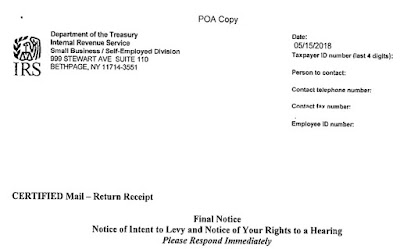Practitioners sometimes call it “falling
on the sword.”
There is likely a phone call to the insurance company beforehand.
Something went wrong. The client now owes tax, interest, maybe penalties.
Just
because that happens does not mean the practitioner was wrong. It can happen
any number of ways.
· The classic: the
client does not provide all paperwork to the practitioner.
Mind you, sometimes the practitioner can tell:
… hey, you have
had this account for years, but I am not seeing it this year. Do you still have
the account?
And sometimes … you can’t tell. Perhaps it is a one-off. You never saw it before and you never will again, but it is there for that one year.
All the while, IRS computers are whirring and matching. They will let you know if you leave something out.
· The tax answer is
uncertain.
How can that happen?
New tax law is one way. It takes a while to get guidance out there. We saw this recently with the employee retention credit. Congress passed a law, and the IRS did its best interpreting it in real time. Its best was problematic, and the IRS subsequently paused ERC processing because of the number of fraudulent filings.
· The client goes to audit but does not have the documentation necessary to support a tax position.
I think of real estate professional status, especially if one has a job outside real estate. The IRS is going to hammer on the hours worked, and you better have something other than stories to support your position.
A variation on the above is that the IRS disagrees with your documentation.
Conservation easements are a current example of these.
· The audit from hell
One cannot do representation work and not have stories to tell.
I was hired by another CPA for a research credit audit.
The IRS agent had visited the CPA’s office, at which time he reviewed interim (think monthly or quarterly) accountings. The interims were prepared on an accrual basis, meaning that the accounting included accounts receivable and payable.
The tax return, however, was cash basis, meaning that no receivables or payables were recorded.
This is extremely common. Depending upon, I might consider the failure to do so to be malpractice.
The agent considered this to be two sets of books.
Translation: he thought indices of fraud.
I thought that the IRS should tighten up its hiring standards. Having someone work business tax without having an adequate background in accounting is insane.
It cost time. It cost goodwill. And it had nothing to do with the audit of a research tax credit.
I am looking at a case that went sideways. I also see that neither the taxpayers nor the IRS appeared at the Tax Court hearing.
The taxpayer was a teacher, and his wife was a nurse. They had a joint real estate business, and the wife had previously owned a nursing business. Although the nursing business had closed, it still showed deductions for the tax year under issue.
The IRS had proposed adjustments, and the taxpayers had acceded.
The taxpayers did not agree to a substantial understatement penalty, though.
COMMENT: Think of this as a super penalty. It can flat-out hurt.
I’ve got the lay of the land now. Taxpayers wanted reasonable cause for abatement of the penalty. That reasonable cause would be reliance on a tax professional. There are requisites:
(1)
The issue must be one of professional judgement
and more than the routine processing of a tax return.
(2)
The tax preparer must be competent.
(3)
The taxpayers must have provided the preparer
all relevant facts.
(4)
The taxpayers must have relied on the preparer’s
judgment.
(5)
The taxpayers were injured by such reliance.
(1)
The taxpayers did not testify.
(2)
The tax preparer did not testify.
(3)
The tax preparer deducted expenses for a
business no longer in operation during the year in question.
(4)
The tax preparer reported business expenses on
incorrect schedules.
(5)
The preparer did not sign the return.
The preparer had no intention of falling on the sword, it seems. The taxpayers had every intention of holding him responsible, though. They had to if they wanted penalty abatement.
It wasn’t going to happen.
Why?
The preparer did not sign the return, considered a big no-no in practice.
The Court was swift: taxpayers had not proven that the preparer was even competent.
Our case this time was Hall v Commissioner, U.S. Tax Court, docket No. 3467-23.



